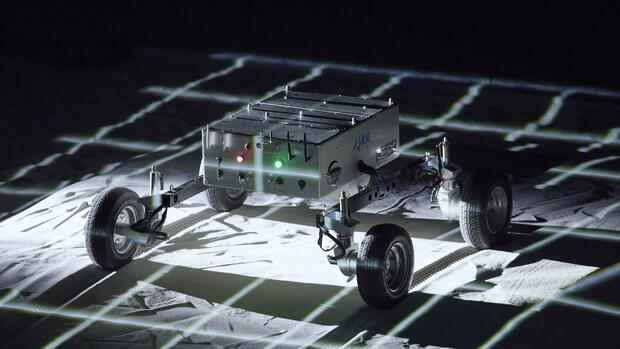In the weekly column, we alternately write about innovation and economic trends in Asia.
(Photo: Klawe Rzeczy)
Tesla founder Elon Musk shot a car into space with his space company SpaceX and is mentally already on the way to Mars. Japan’s carmakers are content to conquer the moon in the space race for the time being, but want to be pioneers here: Last week Nissan presented the prototype of an autonomous lunar vehicle that the company developed with Japan’s space agency Jaxa.
The design doesn’t look very futuristic: A box-shaped control unit on four wheels, which is supposed to rumble over the moonstone rubble with Nissan’s technology for autonomous driving and all-wheel drive. For the Jaxa, the inconspicuous vehicle is an important step towards the economic development of space.
For the Japanese government, the industrialization of space is a pillar of its strategy for economic security. Jaxa therefore works on their behalf with companies, universities and research institutes on projects “that are feasible and have the potential for commercialization,” said Ikkoh Funaki, director of the Jaxa innovation center for space research. The three largest Japanese auto companies Toyota, Honda, and Nissan play an important role in the plans for the lunar economy.
It all started with Toyota, who presented the concept for a six-seater lunar bus with hydrogen drive and an oxygen cabin as early as 2019. The bus should cover more than 10,000 kilometers, so that the occupants would get around the moon completely. The hydrogen could then come from Honda. Because the Toyota rival decided with the Jaxa in mid-2021 to jointly develop a cycle for renewable energies in space.
Top jobs of the day
Find the best jobs now and
be notified by email.
The idea: Honda is further developing its existing earthly technology in order to obtain hydrogen and oxygen in space through electrolysis from moon ice. The oxygen will then, on the one hand, enable people to breathe and, on the other hand, deliver electricity in fuel cells through fusion with hydrogen. The resulting water is to be fed back into the hydrogen supply chain.
The big Japanese automakers are preparing to settle the moon with the domestic space agency Jaxa.
(Photo: imago)
Jaxa is also already working on the exploitation of the larger water reserves required for this, which are suspected to be frozen on the earth’s satellite: with JGC, a global project developer for oil and gas production. The company specializes in the production of liquid water and oxygen for fuel cells in the automotive industry. Now they should also bring their technology to the moon.
Japan seeks long-term economic security on the moon
In contrast to terrestrial electromobility, the Japanese carmakers want to be pioneers in lunar mobility. The automotive lunar projects are much more than the result of a mere sense of duty on the part of car manufacturers to contribute to national projects. They also testify to the refusal of the “Japan AG” to unconditionally limit itself to “concentrating on core competencies”. Toyota and Honda in particular made long-term investments early on, also in other industries.
One example is the hybrid drives, which were ridiculed by the competition for a long time until they were also widely accepted. In addition to cars, Toyota is also developing artificial intelligence, building motorboats, robots, prefabricated houses and even its own Smart City at the foot of the Fuji World Heritage volcano. Honda, on the other hand, launched the six-seater “HondaJet” in 2015 as the first Japanese company since World War II to bring an aircraft (albeit a small one) onto the market.
The lunar projects are not geared towards the short-term time horizon of the average investor. Even the Jaxa do not consider the beginning of a more extensive lunar settlement to be likely until after 2040, before commercialization of the technologies is not to be expected. But before that, a boom for satellite launches is expected, from which Japan wants to make money in the meantime.

Jaxa is already planning to build reusable missiles with a large industrial consortium by 2030. Honda could play a decisive role in near-earth orbits: In September, the carmaker promised, among other things, the development of inexpensive, reusable small space rockets as part of its future projects. The Japanese want Elon Musks world market leader SpaceX to steal market share in space colonization.
More: Japan wants to protect the climate with concrete of all things
